Halawa Correctional Facility Makahiki...
















































































A beautiful expression of hope, forgiveness, and Aloha pau'ole...
In tradition, Makali'i was a celebrated transpacific voyager and astronomer. He shared the Hawai'ian name for the star cluster Pleiades (Makali'i means "finely meshed netting") and became the trusted navigator of the chief Hawai'iloa. After sailing to Hawai'i, Makali'i settled on Kauai'i: all commoners are said to be descended from him.
Makali'i was an expert at cultivating taro, sweet potato, yam and other crops. In times of plenty, Makali'l would set aside a portion of his harvest, tying it safely in a carrying net and suspending it high up in the heavens. Legend says that on one occasion, when famine struck the islands, rats scoured the earth, desperately seeking food. They smelled Makali'i's net of plenty and saw it hanging way above them. Climbing rainbows and clouds, they got close enough to the net to gnaw the cordage at the piko (bottom centre). They were able to release some of the food, which fell to earth, took root and fed the people.
In honour of Makali'i, one month of the ancient calendar year was named after him. Makali'i was one of the four lunar months related to harvest in the season known as the Makahiki. The Makahiki commenced in the month of 'Ikuwa (roughly corresponding to October-December), continued through Welehu (November-December) and and Makali'i (December-January), ending in Ka'elo (January-February). Hawai'ians reserved this time of year to honour their Lono gods, who were present in clouds, storms, thunder, lightning, earthquakes, rain, wind and crop fertility. These gods also had the power to prevent sickness and disaster.
The Makahiki opened with ritual prayer and offerings. Midway through the season, all temple worship was suspended. A coconut dish was broken to symbolise the lifting of restrictions and the entire population was free of the severe prohibitions that were punishable by death during the rest of the year. Hard labour was forbidden and chiefs and commoners engaged in relaxation, sport and spectator activities.
Another function of the Makahiki was the annual collection of taxes, heralded by a procession of carved images. For several days, priests and chiefs made a circuit of the island to gather the taxes, in the form of goods, from the commoners. The procession was led by Lonomakua, the akua loa, or "the god who travelled afar", a carved image that topped a long, decorated pole. The pole was about 12 feet tall, with a 16 foot cross-pole adorned with pala ferns, feather lei, skins of the ka'upu bird (albatross) and draped lengths of white barkcloth, or kapa. There was also an akua poko, or "short god", which traversed the distance between districy boundaries, followed by commoners who gathered edible and decorative upland ferns. A third carved image was the akua pa'ani, which marked the gaming areas where contests took place; this image accompanied the akua loa around the island.
The end of the Makahiki was signaled by the dismantling of the images for storage in the temple of the war god, Ku and by a special closing ceremony that commemorated the bounty that Makali'i had placed in the sky. At the direction of a priest, four men filled a net with taro, sweet potato, yam breadfruit, banana, coconut and pork. They then shook the net. If all the items fell through the net, the new year would be prosperous and productive. However, if any food remained in the net, the people knew to expect famine and to prepare for it.
As the Makahiki came to a close, the stringent worship of Ku, with all it's accompanying restrictions on foods, silence and movement, was enforced once again and life took on a different order and meaning. (Mahalo Carol Silva)



Comments